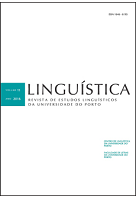Interphrasal manual and non-manual connections in LGP: a preliminary study
Abstract
In sign language, sentence connections are not always explicit, or so easily identifiable as in spoken / written language, since these seem to be mostly undertaken by non- lexical elements. This study aims to describe the structures related to different values associated to the connector “and” in Portuguese Sign Language (Língua Gestual Portuguesa – LGP). The challenge lies in the fact that the copulative connector, besides entailing different meanings in Portuguese, does not seem to be lexicalized in LGP. Thus, we selected a set of copulative coordinate clauses with additive, temporal, inferential, contrastive and conditional values and their syntactic-semantic equivalents in Portuguese, using, in addition to “and”, other commonly used connectors (“but”, “although”, “therefore”, “after”, “if”). For each sentence in Portuguese, native speakers of LGP produced isolated translations, where it was possible to identify lexical marks, such as conjunctions (“BUT”, “THEN”, “WHILE”, “AFTER”, “AS-SOON-AS” “HOWEVER”, “IF”), adverbs, verbs and other expressions that reinforce the meaning conveyed. The analysis of these productions show that most of the sentences present prosodic connections, i.e., non-manual connectors that emerge consistently: neutral expression, frown and raised eyebrows. In LGP, lexical connectors are mostly used in the three syntactic structures that express contrast, especially in adversative coordinates (“BUT”, “HOWEVER”). On the other hand, non- manual connectors appear mostly in asyndetic coordinates and in those connected by “and” associated to temporal and conditional values. Comparing the use of lexical and prosodic connections in LGP, it can be concluded that non-manual connectors seem to be very productive, even when there is a direct sign translation for a particular connector in Portuguese.
References
Dechandt, Sônia Brochardo. 2006. A Apropriação da Escrita por Crianças Surdas. In: Quadros, Ronice Muller de (Ed.). Estudos Surdos I. Série Pesquisas. Rio de Janeiro: Editora Arara Azul, 284-322.
Duarte, Inês. 2003. Aspectos Linguísticos da Organização Textual. In: Mateus, Maria Helena Mira, et al.. In: Gramática da Língua Portuguesa. Colecção Universitária, Série Linguística. Lisboa: Caminho, 85-123.
Fernandes, Eulalia. 2003. Linguagem e surdez. Porto Alegre: Artmed.
Hermann, Annika. 2012. Prosody in German Sign Language. In: Elordieta, Gorka & Prieto, Pilar (Eds.). Prosody and Meaning. Berlin / New York: Mouton de Gruyter, 349-380. Mateus, Maria Helena Mira, et al.. 2003. Gramática da Língua Portuguesa, 7.ª edição. Lisboa: Editorial Caminho.
Matos, Gabriela. 2003. Estruturas de coordenação. In: Mateus, Maria Helena Mira, et al.. In: Gramática da Língua Portuguesa. Colecção Universitária, Série Linguística. Lisboa: Caminho, 549-592.
Pfau, Roland & Quer, Joseph. 2010. Nonmanuals: Their Grammatical and Prosodic Roles. In: Brentari, Diane (Ed.). Sign Languages. Cambridge: Cambridge University, 381-402.
Quadros, Ronice Muller de. 2011. Sintaxe das línguas gestuais. Coleção Pro-LGP, vol. 17. Lisboa: Universidade Católica Editora.
Quadros, Ronice M. & Schmiedt, Magali L. P.. 2006. Idéias para Ensinar Português para Alunos Surdos. Brasília: Secretaria de Educação Especial, Ministério de Educação e Cultura.
Quer, Josep. 2016. Intonation and grammar in the visual-gestural modality: A case study on conditionals in Catalan Sign language (LSC). In: Armstrong, Mehan E., et al.. Intonational Grammar in Ibero-Romance: Approaches across linguistic subfields. Amsterdam: John Benjamins Publishing Company, 369-386.
Sandler, Wendy & Lillo-Martin, Diane. 2006. Sign Language and Linguistic Universals. Cambridge: Cambridge University Press.
Downloads
Published
Issue
Section
License
Copyright (c) 2017 Linguística Revista de Estudos Linguísticos da Universidade do Porto

This work is licensed under a Creative Commons Attribution-NonCommercial 4.0 International License.



